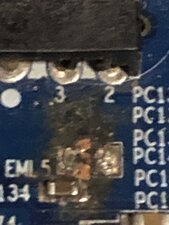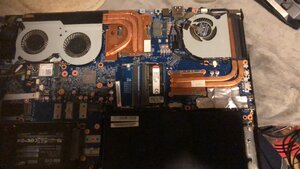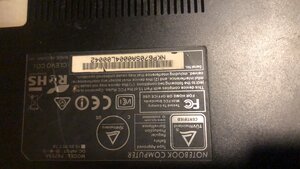@bowmeat picture 1 and 2 are a bit to close. We need to see more of the surrounding area as well as the reference designator (those white printed numbers and letters). See if you can get a little better focus on the images :-)
If it says EML5 right next to the component then it is a HCB2012kf-800T80 EMI/RFI Filter (Ferrite Bead Inductor). Essentially you are looking for a ferrite bead filter (inductor) 80 Ohms, 8A max rated current in a 0805 package. kind of hard to find due to the high amperage but you do have some wiggle room. You can always go a bit higher. Something like this will work but it is a 0.2mm shorter. You will need to bridge that small gap with your soldering.
It's doable and not as complicated as it seems. It is also relatively inexpensive. Of course, you can purchase the component from wherever you have easy access to. I just use the company in the link a lot and know what they sell. No kickbacks involved :-)
To work on your computer and to scope out the rest of the circuitry, if you ever have the need to do so, use the Cleevo P670SA Service Manual which does include the schematic.
crwdns2934105:0crwdne2934105:0
crwdns2934113:0crwdne2934113:0
crwdns2915270:0crwdne2915270:0
crwdns2889612:0crwdne2889612:0
1





 2
2 
 397
397  1,5crwdns2936485:0crwdne2936485:0
1,5crwdns2936485:0crwdne2936485:0 
crwdns2944067:05crwdne2944067:0
Unsure on how to add pictures
Thx Shane
crwdns2934271:0crwdnd2934271:0 Bowmeat crwdne2934271:0
Hi @bowmeat
What is the model number of the motherboard (printed on the board) and the make and model number of the laptop (if you can't find the board model number)?
Was the laptop turned on and working at the time this occurred?
crwdns2934271:0crwdnd2934271:0 jayeff crwdne2934271:0
As far has I am aware it was powered off because the battery I goosed , where would I find the model number , ?
Thx for the reply
crwdns2934271:0crwdnd2934271:0 Bowmeat crwdne2934271:0
I know it’s a laptop . But it never moves so I wouldn’t be bothered hard wiring it to the charger if possible , , if that makes sense
crwdns2934271:0crwdnd2934271:0 Bowmeat crwdne2934271:0
Thx for the reply’s
I don’t think I would be confident to do this with my lack of knowledge and crap equipment , does anybody know anywhere local to Leeds uk that would. Try this fix for me ? Also any ideas on prices I could be looking at ,,
Thx Shane
crwdns2934271:0crwdnd2934271:0 Bowmeat crwdne2934271:0